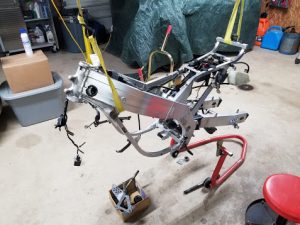We started the project by doing a complete teardown down to the frame of the RGV rolling chassis. Wheels were removed, front end, swingarm, rear shock and linkage, subframes, and wiring were all removed.

I then proceeded to completely disassemble the front forks at which point I had to decide if I was going to upgrade the existing forks or perhaps upgrade to a new front end that uses cartridge based suspension. I decided to upgrade the existing forks. I am still not sure I made the right decision, but it is the path I am on for now. Forks from another model that already used upside down cartridge forks with better brake calipers may still be on the horizon. I completely disassembled the forks and inspected the components. The fork tubes had some light rust, but I believe are still serviceable. Other than the black oil, the internals looked pretty good. The fork legs did look pretty rough on the outside so I decided to try out vapor blasting on them. There is a shop in Cleveland that has a vapor blasting machine and allowed me to use it for a modest fee. You can see the before and after below:


I contacted Matt Wiley at Race Tech; he is their vintage suspension specialist. With the information I gave him, he recommended a setup with stiffer springs and their gold valve emulators as well as a quality 15W fork oil. I also had him supply the fork bushings, inner and outer, as even though the existing bushings were still in decent shape, they really should be replaced when the fork tubes are separated.
In our next entry, I delve into some of the issues I had while rebuilding the forks as well as the rear shock.
